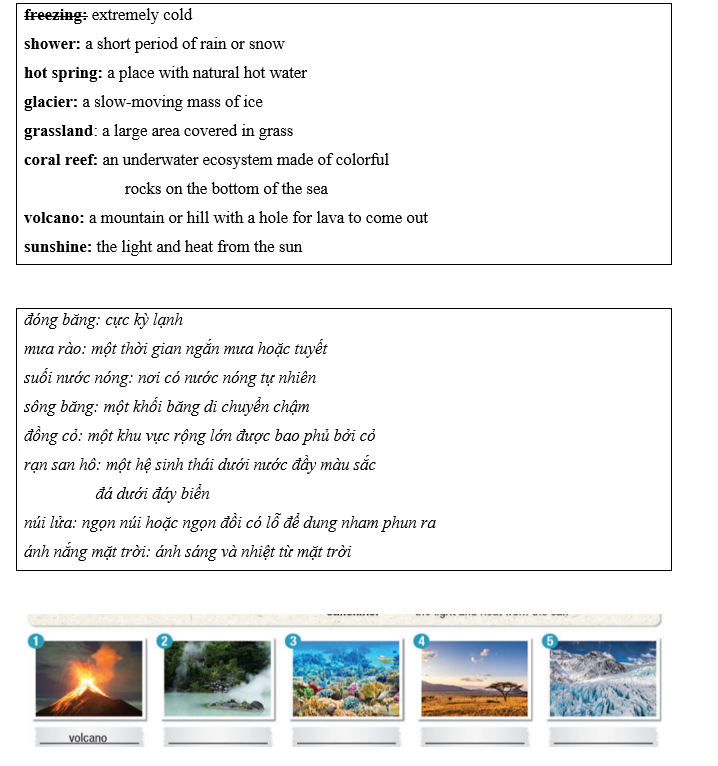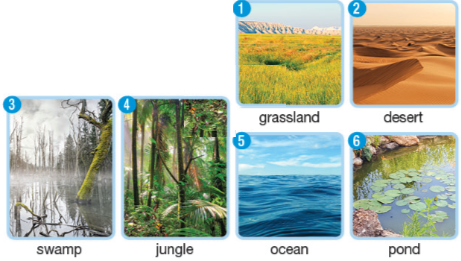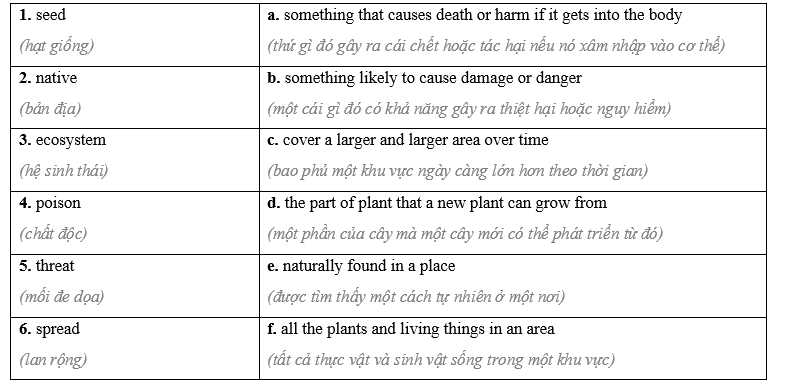a. Circle the correct definitions for the underlined words. Listen and repeat.
(Khoanh tròn các định nghĩa đúng cho các từ được gạch chân. Lắng nghe và lặp lại.)
1. The ecosystem in the Amazon has over three million animals and 2,500 kinds of trees.
(Hệ sinh thái ở Amazon có hơn 3 triệu loài động vật và 2.500 loại cây cối.)
a. all the plants, living things, and environment in an area (tất cả các nhà máy, sinh vật sống, và môi trường trong một khu vực)
b. a way to organize plants and animals (một cách để tổ chức thực vật và động vật)
2. Things like plastic and air pollution are a threat to the environment.
(Những thứ như nhựa và ô nhiễm không khí là mối đe dọa đối với môi trường.)
a. something likely to cause damage or danger (một cái gì đó có khả năng gây ra thiệt hại hoặc nguy hiểm)
b. a way to improve someone or something (một cách để cải thiện một ai đó hoặc một cái gì đó)
3. The insects spread across the country and can now be found in every city.
(Loài côn trùng này lan rộng khắp đất nước và hiện có thể tìm thấy ở mọi thành phố.)
a. move from one place to another (di chuyển từ một nơi này đến nơi khác)
b. cover a larger and larger area over time (bao phủ một khu vực ngày càng lớn hơn theo thời gian)
4. If there are mice or insects in your home, you can kill them with poison.
(Nếu trong nhà có chuột hoặc côn trùng, bạn có thể tiêu diệt chúng bằng thuốc độc.)
a. something that causes death or harm if it gets into the body (thứ gì đó gây ra cái chết hoặc tác hại nếu nó xâm nhập vào cơ thể)
b. something that gives you more energy (một cái gì đó cung cấp cho bạn nhiều năng lượng hơn)
5. We can grow a new tree if we plant a seed.
(Chúng ta có thể trồng một cây mới nếu chúng ta gieo một hạt giống.)
a. the small round part of plant that can become a new plant (phần tròn nhỏ của cây có thể trở thành cây mới)
b. the part of plant that is normally below the ground (một phần của cây mà thường là dưới mặt đất)
6. Wild tigers are native to Asia. They have always lived there.
(Hổ hoang dã có nguồn gốc từ châu Á. Họ đã luôn sống ở đó.)
a. (of plants and animals) coming from somewhere else ((của thực vật và động vật) đến từ nơi khác)
b. (of plants and animals) existing naturally in a place ((của thực vật và động vật) tồn tại tự nhiên ở một nơi)


Các bài tập cùng chuyên đề
Plants and animals (Thực vật và động vật)
1. Match the words and phrase with their meanings.
(Nối các từ và cụm từ với ý nghĩa của chúng.)
|
1. native (adj) |
a. a group of animals or plants that have similar characteristics |
|
2. tropical forest (np) |
b. the protection of the natural environment |
|
3. species (n) |
c. any animal that gives birth to live young, not eggs, and feeds its young on milk |
|
4. conservation (n) |
d. thick forest that grows in the hot parts of the world |
|
5. mammal (n) |
e. existing naturally in a place |
2. Complete the sentences using the correct form of the words and phrase in 1.
(Hoàn thành các câu sử dụng dạng đúng của các từ và cụm từ trong 1.)
1. ___________ usually have a great variety of flora and fauna.
2. Many young people are really interested in wildlife ____________ nowadays.
3. Koalas and kangaroos are ____________ to Australia only.
4. Cat Ba National Park has many plant ___________ that can be used as medicine.
5. Some groups of ___________, including lions and tigers, eat mainly meat.
Choose the correct word or phrase to complete each sentence.
(Chọn từ hoặc cụm từ đúng để hoàn thành mỗi câu.)
1. Cuc Phuong National Park has a large number of flora and fauna (species / regions).
2. Many species are saved from disappearing by (biodiversity / conservation) efforts.
3. Reducing the use of fresh water can help to protect marine (ecosystems / national parks).
4. The overuse of (natural resources / climate change) may lead to loss of biodiversity.
6 Write as many questions as you can that you could ask about the size and dimensions of
(Viết càng nhiều câu hỏi càng tốt mà bạn có thể hỏi về kích cỡ và kích thước của: 1. cái hồ; 2. cái hộp; 3. một người; 4. một tòa nhà.)

1 How deep is it? How...
(1 Nó sâu bao nhiêu? ...)
a. Read the definitions and match the words with the pictures or fill in the blanks. Listen and repeat.
(Đọc các định nghĩa và nối các từ với hình ảnh hoặc điền vào chỗ trống. Lắng nghe và lặp lại.)

6. The weather in Russia is often snowy and freezing.
7. My plants get a lot of _______________ through the window.
8. I didn't take my umbrella today because it was only a _____________.
1. Listen and repeat.
(Nghe và lặp lại.)

2. Complete the statements with the words (1-6) from Exercise 1. Then listen and check.
(Hoàn thành các câu với các từ (1-6) từ Bài tập 1. Sau đó nghe và kiểm tra.)
1. Temperatures in the Sahara _________ can reach 58°C.
2. A(n) _________ is neither water nor land but a mix of both.
3. Some areas of the _________ are 10,000 metres deep.
4. Over half of the world's animal species live in the _________.
5. Plants grow in a(n) _________ because sunlight reaches the bottom.
6. Grass in the southern _________ can grow over 2 metres tall.
3. Complete the sentences with the words below.
(Hoàn thành các câu với các từ dưới đây.)

1 The park organisation tries to _________ the waters around the coral reef in order to protect it.
2 Scuba diving and other _________ activities can damage the coral reef.
3 Warmer ocean temperatures can cause _________ in which the coral turns white and dies.
4 Pollution poses a major _________ to coral reefs.
5 We must protect the fish population and stop _________
6 Pollution, tourism and overfishing are the reasons that _________ marine animals, so we have to take action to prevent them.
4. Complete the list below with the words and phrases in red in Exercise 3. Then listen, check and repeat.
(Hoàn thành danh sách dưới đây với các từ và cụm từ được tô màu đỏ trong Bài tập 3. Sau đó nghe, kiểm tra và lặp lại.)
be made up of = be formed from
come across = ____________
come in = ____________
die out = ____________
go out = ____________
heat something up = ____________
stir something up = ____________
5. Complete the sentences with the correct words in the box.
(Hoàn thành các câu với các từ đúng trong hộp.)
| bins bulbs change energy issues panels warming |
1. Solar panels make buildings look ugly.
2. There aren't enough recycling ______ in my area.
3. Climate ______ doesn't affect my country.
4. More renewable ______ is the only way to stop global
5. Everybody should use low-energy light ______ to save electricity.
6. Our government is not interested in environmental ______.
VOCABULARY AND GRAMMAR
1. Match the words in A with the words in B to make Word Friends.
(Ghép các từ trong A với các từ trong B để tạo thành Word Friends.)
|
A 1. calm (lặng) 2. mountain (núi) 3. become (trở nên) 4. tropical (nhiệt đới) 5. low (thấp) 6. find (tìm thấy) |
B a. by chance (tình cờ) b. tide (thủy triều) c. extinct (tuyệt chủng) d. range (dãy) e. island (đảo) f. sea (biển) |
LANGUAGE IN USE
4. Complete the text with the correct form of the words in brackets.
(Hoàn thành đoạn văn với dạng đúng của các từ trong ngoặc.)
THE ENVIRONMENT
People didn't use to worry about the environment much when I was a child. There were no 1_______ (recycle) bins in my town, so we would put all our litter in one bag and throw it away. The government kept focusing on economic 2_______(grow) so that everyone had a well-paid job, a three-bedroom house and a powerful car.3_______(forest) was just a difficult word to pronounce and we were not aware of the consequences of cutting down the rainforests. We didn't oppose the 4_______ (destroy) of wildlife habitats as it was part of progress. It took us many years to realise that we won't be able to survive as a species without having clean 5_______(renew) energy sources, like solar power, or without stopping global warming. I hope it is not too late for our planet to make a full 6_______(recover) after all the damage we have done to it.
b) Use the phrases in Exercise 1a to fill in the gaps and/or choose the correct verb.
(Sử dụng các cụm từ trong Bài tập 1a để điền vào chỗ trống và/hoặc chọn động từ đúng.)
EARTH DAY
Hi everyone!
Today is Earth Day, so let's all try our best to reduce our carbon footprint as much as we can and keep it as low as possible. Are you stuck for ideas of what to do? Then let me help. Here are some steps you can take and can start right away!
• 1) Recycle/Use rubbish - put paper, glass, aluminium and plastic in the right bins.
• 2) Don't get rid of/Use _____________ - put leftover food in the freezer for another meal or put it in the compost bin.
• 3) Use/Recycle less electricity - turn off lights and devices when you aren't using them. • 4) Drink from _____________ to cut down on plastic waste.
• 5) Shop with your own _____________ that you can reuse over and over again.
• 6) Get/Drive a(n) _____________ or take the bus or cycle everywhere.
• 7) Use/Shop _____________ appliances to save energy.
• 8) Get rid of/Eat your own_____________ after growing it in your garden or on your balcony.
Hope this helps. Let me know your ideas in the comments.
Mark the letter A, B, C or D to indicate the word(s) OPPOSITE in meaning to the underlined word(s) in each of the following questions.
Many animals were born in captivity. Resultantly, they do not always breed well.
-
A.
imprisonment
-
B.
lock
-
C.
detention
-
D.
freedom
1. Put the words in the box into the correct column.
(Đặt các từ trong hộp vào đúng cột.)

2. Complete the sentences using the correct forms of the words in brackets.
(Hoàn thành câu sử dụng dạng đúng của từ trong ngoặc.)
1. Deforestation of the area was stopped by the local community’s _________ efforts. (converse)
2. Some animals are in danger because their _________ habitats are being destroyed. (nature)
3. Scientists have discovered millions of __________ things on our planet. (live)
4. Asian elephant is one of the largest __________ in the world. (mammal)
5. You can have a lot of fun exploring the beautiful _________ parks in the region. (nation)
6. Conserving natural resources can help prevent the ________ of biodiversity on our planet. (lose)
7. Each plant helps protect _________ and supports the ecosystem of an area. (biodiverse)
8. The rare Javan rhino is the world’s most __________ animal. (danger)
3. Complete the sentences using the correct forms of the words and phrase in the box.
(Hoàn thành các câu sử dụng dạng đúng của các từ và cụm từ trong hộp.)

1. Creating __________ areas for endangered species is one way to save wildlife.
2. There are many different types of __________ around the world from forests to deserts and from small lakes to the open sea.
3. __________ is essential for the processes that support all life on Earth.
4. __________ not only cool the earth’s surface, but also provide us with food and water.
5. It is believed that there are more than five million __________ of insects, but only one million have been found and described.
6. Scientists estimate that 25 percent of all marine species live in and around __________.
7. A __________ describes how each living thing gets food, and how energy and nutrients are passed from one creature to another.
8. Biologists have found more than 350 mammal species __________ to Australia.
a. Complete the words.
(Hoàn thành các từ.)

b. Fill in the blanks with the words from Task a.
(Điền vào chỗ trống với các từ trong Phần a.)
1. The _____ around Đà Nẵng is beautiful because you can see beaches and mountains.
2. Much of Central Vietnam is covered in thick _____.
3. Ha Long Bay is famous for its unique _____ rock towers.
4. The mountains in Tràng An are formed from _____.
5. The _____ wildlife in Vietnam cannot be found anywhere else.
6. It’s important to protect _____ in Vietnam.
a. Match the words to the definitions.
(Nối các từ với các định nghĩa.)

b. Now, read about cane toads and fill in the blanks.
(Bây giờ, hãy đọc về cóc mía và điền vào chỗ trống.)

Cane toads were introduced into Australia in 1935. They were used to help control insects. These insects were causing problems for farmers for years. The toads have now (1) _____ to many other parts of the country. Some of Australia’s (2) _____ animals hunt the cane toads. However, cane toads’ bodies contain a (3) _____. It can hurt or even kill other animals. Cane toads have become a (4) _____ to Australia’s (5) _____.
a. Complete the words.
(Hoàn thành các từ.)

b. Fill in the blanks.
(Điền vào chỗ trống.)
1. I saw lots of colorful fish around the _____ when I went diving.
2. When I went skiing, I thought the weather would be _____ cold.
3. After hiking all day, it was nice to relax and take a bath in the _____.
4. The weatherman said there would be a storm, but it was only a _____.
5. Antarctica is very cold, and there’re over 1,600 _____s there.
6. Some people think these places are scary because the temperature is so hot, but I’d love to visit a _____.
7. I love going to the beach when there’s _____, but not on cloudy days.
8. Animals like elephants, giraffes, and lions live in the African _____.






